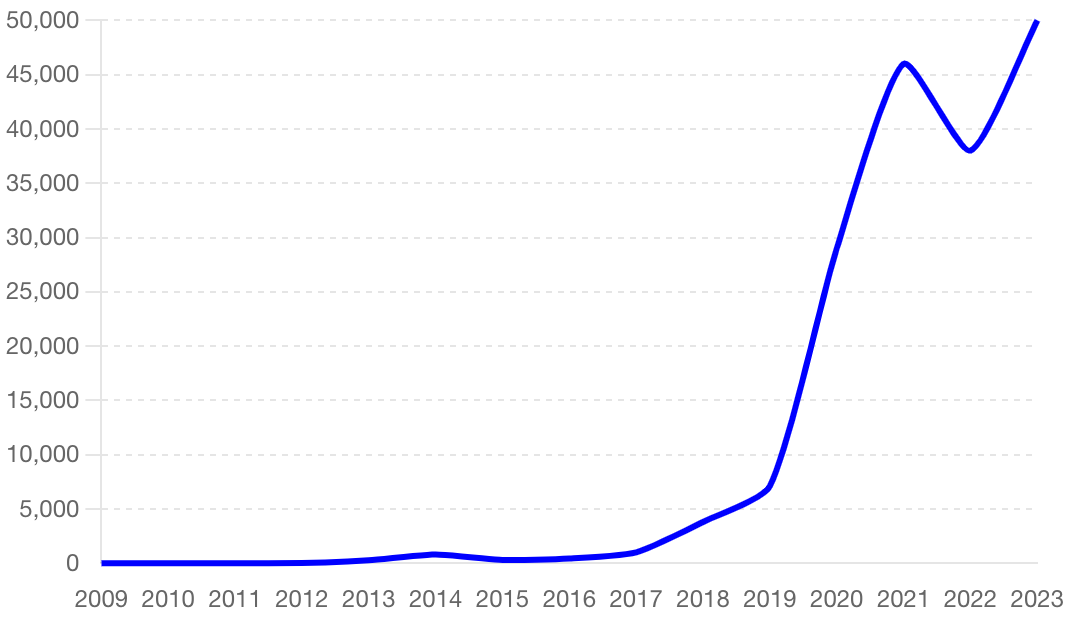Bitcoin, the world’s leading cryptocurrency, has revolutionized the way we think about money. In this comprehensive guide, we’ll explore what Bitcoin is, how it works, and why it’s so valuable.
History of Bitcoin
Bitcoin was introduced in January 2009 by an anonymous person or group known as Satoshi Nakamoto. The idea behind Bitcoin was to create a decentralized digital currency that allows for peer-to-peer transactions without the need for a central authority. The Bitcoin network started with the mining of the first block, known as the Genesis Block.
Over the years, Bitcoin has experienced significant milestones. In 2010, the first commercial transaction using Bitcoin was completed when a programmer paid 10,000 BTC for two pizzas. By 2013, Bitcoin’s price exceeded $1,000 for the first time, attracting major media attention. In recent years, Bitcoin has been adopted by numerous businesses and even some governments, solidifying its role as a major player in the financial world.
Major Events in Bitcoin’s Journey
2008
- Whitepaper Published: Satoshi Nakamoto publishes the Bitcoin whitepaper titled “Bitcoin: A Peer-to-Peer Electronic Cash System” on October 31, outlining the principles of a decentralized digital currency.
2009
- Bitcoin Network Launched: Bitcoin software is released to the public in January, and the first block, known as the Genesis Block, is mined by Satoshi Nakamoto on January 3.
2010
- First Bitcoin Transaction for Goods: On May 22, Laszlo Hanyecz makes the first real-world transaction using Bitcoin, buying two pizzas for 10,000 BTC. This day is now celebrated as “Bitcoin Pizza Day.”
- Bitcoin Exchange: The first Bitcoin exchange, BitcoinMarket.com, is established, allowing users to trade Bitcoin for USD.
2011
- Bitcoin Reaches Parity with the Dollar: In February, Bitcoin reaches parity with the US dollar, with 1 BTC equal to 1 USD.
- Silk Road: The darknet marketplace Silk Road launches, using Bitcoin as its primary currency, increasing Bitcoin’s visibility and use.
2013
- Price Surge: Bitcoin’s price surges to over $1,000 for the first time in November.
- Regulatory Attention: Various governments and regulatory bodies start to notice Bitcoin, leading to increased scrutiny and regulation.
2014
- Mt. Gox Hack: In February, the largest Bitcoin exchange at the time, Mt. Gox, collapses after a major hack, resulting in the loss of 850,000 BTC.
2016
- Halving Event: The second Bitcoin halving occurs, reducing the block reward from 25 BTC to 12.5 BTC, highlighting the deflationary nature of Bitcoin.
2017
- Mainstream Adoption: Bitcoin sees significant growth, with its price reaching nearly $20,000 in December.
- SegWit Activation: Segregated Witness (SegWit) is activated to address scalability issues and reduce transaction fees.
- Bitcoin Cash Fork: In August, Bitcoin undergoes a hard fork, resulting in the creation of Bitcoin Cash (BCH).
2020
- Institutional Investment: Companies like MicroStrategy, Square, and Tesla begin investing in Bitcoin, signaling growing institutional interest.
- Third Halving Event: The third Bitcoin halving occurs in May, reducing the block reward to 6.25 BTC.
2021
- All-Time Highs: Bitcoin reaches new all-time highs, surpassing $60,000 in March.
- El Salvador: In September, El Salvador becomes the first country to adopt Bitcoin as legal tender.
2022
- Market Volatility: Bitcoin experiences significant price volatility, impacted by global economic conditions and regulatory developments.
- Further Adoption: More countries and institutions continue to explore Bitcoin and blockchain technology.
2023
- Ongoing Developments: Bitcoin continues to evolve with improvements in technology, increased adoption, and ongoing regulatory discussions.
What is Bitcoin?
Bitcoin started in January 2009 by an unknown person or group called Satoshi Nakamoto. It is a digital currency that exists only online. It works like virtual cash, letting you buy and sell things globally. However, some countries and stores still do not accept Bitcoin.
Bitcoin is a type of cryptocurrency. This means it is decentralized and not controlled by any government or bank. Interestingly, Bitcoin’s value has become higher than gold.
Despite its name, Bitcoin is not a physical coin. Instead, it represents balances kept on a public ledger that anyone can see. This ledger, called the blockchain, checks transactions using a lot of computing power. As a result, there is no need for intermediaries like banks.
How Does Bitcoin Work?
You can store Bitcoin in a ‘digital wallet’ app on your smartphone, computer, or in the cloud. These wallets let you sell Bitcoins or parts of a Bitcoin to other people’s digital wallets. You can also buy Bitcoins from others. Furthermore, a public ledger called the blockchain records every transaction.
The blockchain is a shared digital record of all Bitcoin transactions. Each block in the chain includes details like the date, time, total value, buyer and seller information, and a unique code. Therefore, these blocks link together in order, forming a chain.
Once a block is added to the blockchain, it is accessible to anyone who wants to see it. This shared nature means no single entity controls the blockchain.
Comparisons with Other Cryptocurrencies
While Bitcoin is the first and most well-known cryptocurrency, there are many others that serve different purposes and use different technologies. Here’s a comparison of Bitcoin with some other major cryptocurrencies:
| Feature | Bitcoin (BTC) | Ethereum (ETH) | Litecoin (LTC) |
|---|---|---|---|
| Launch Year | 2009 | 2015 | 2011 |
| Creator | Satoshi Nakamoto | Vitalik Buterin | Charlie Lee |
| Purpose | Digital currency | Smart contracts | Faster transactions |
| Transaction Speed | 10 minutes | 15 seconds | 2.5 minutes |
| Consensus Mechanism | Proof of Work | Proof of Stake (planned) | Proof of Work |
Each cryptocurrency has its unique strengths and weaknesses, making them suitable for different use cases and preferences.
The Largest Cryptocurrency in the World

Bitcoin’s value comes from the shared belief in its worth, like gold. It is the largest cryptocurrency. Moreover, it recently became one of the top currencies in use, following the US dollar and the euro.
How to Get Bitcoin
Getting Bitcoin is simple. First, install a Bitcoin wallet on your computer or phone. This wallet will create your first Bitcoin address. You can make more addresses as needed. A digital wallet acts like a virtual bank account. It lets you buy or sell Bitcoins, pay for goods, and save money on fees. However, unlike traditional bank accounts, Bitcoin wallets are not insured by the FDIC.
There are three main ways to get Bitcoin:
- Buy Bitcoin with Cash: You can buy Bitcoin using real money.
- Sell Products and Services: Accept Bitcoin as payment for goods or services.
- Mine Bitcoin: Use computers to create new Bitcoin.
Is Bitcoin Worth Investing in 2024?

Bitcoin’s popularity comes from its reliable technology and growing use by big companies. As a result, experts think Bitcoin could keep rising in value. However, investors should know that Bitcoin’s value can go up and down a lot.
Future of Bitcoin
As Bitcoin continues to mature, its future looks promising but also faces challenges. Technological advancements such as the Lightning Network aim to improve transaction speeds and reduce fees, making Bitcoin more practical for everyday use.
Regulatory developments will play a crucial role in Bitcoin’s future. Countries are increasingly recognizing Bitcoin, with some embracing it and others imposing restrictions. How governments and financial institutions adapt to Bitcoin will significantly impact its adoption and value.
Market trends suggest that Bitcoin could become a mainstream asset class, with growing interest from institutional investors. However, its volatility remains a concern for many potential users and investors. Ongoing developments in the Bitcoin ecosystem will determine its long-term success and stability.
Summing Up
Hopefully, by this point, there’s no more wondering “What is Bitcoin?”. In conclusion, Bitcoin, often called BTC, has led to the creation of many other cryptocurrencies, like Ethereum. This guide gives a basic understanding of Bitcoin and how it works. For more detailed knowledge, further research is recommended.
At Cash2Bitcoin, you can purchase Bitcoin with cash at any of our ATMs! Click here to find a Bitcoin ATM near you.


